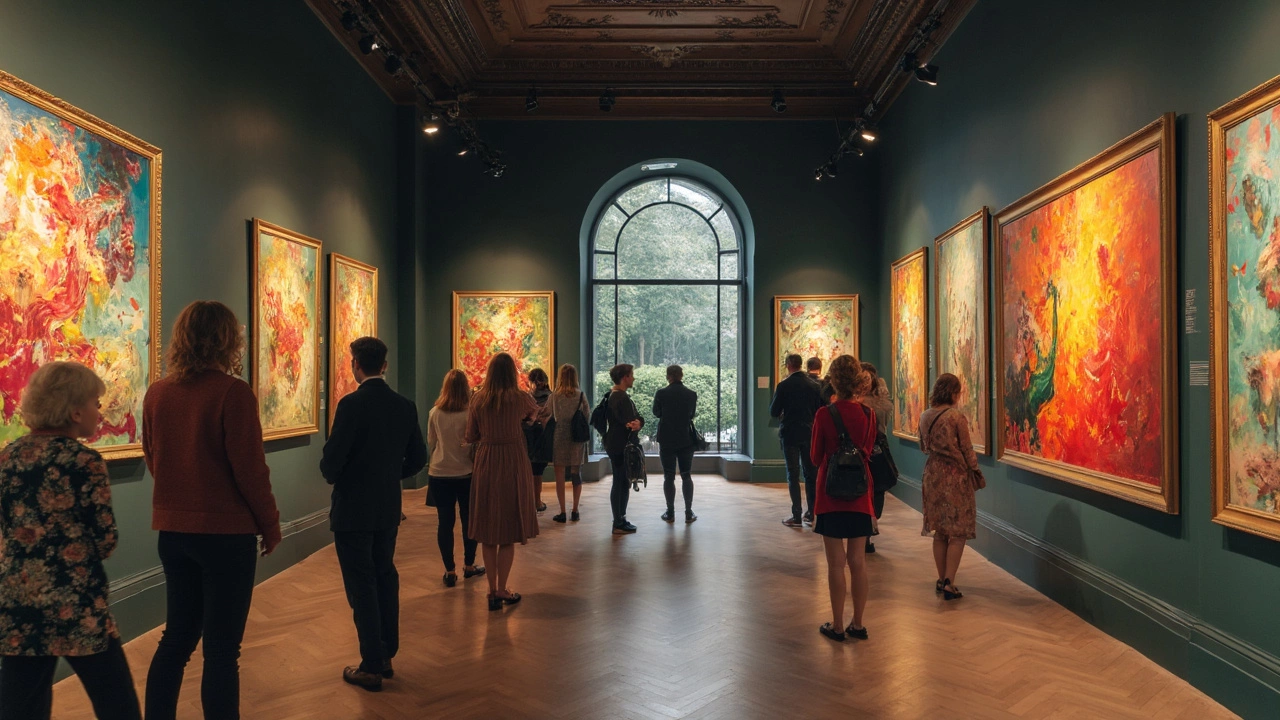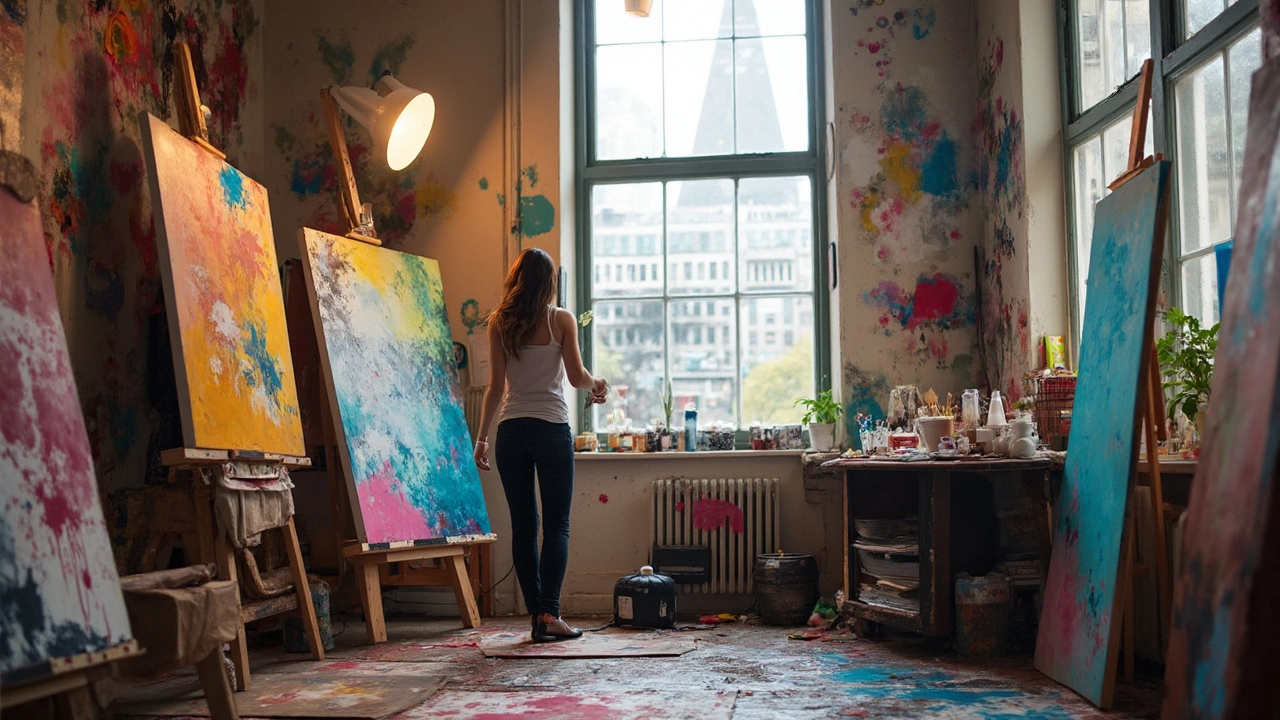Diving into the world of abstract painting can feel like learning a new language. Sure, it offers freedom, but with freedom comes the challenge of knowing how to communicate without literal forms. You know those times when you're staring at a canvas, and the question 'What am I even trying to say?' pops into your head? Yeah, that's pretty common in abstract art.
One of the trickiest aspects is the need to convey emotions and ideas without using recognizable images. This can be daunting, especially if you're used to more traditional art forms that rely on clear subject matters. But don't let that stop you—think of it as a chance to let loose! The emphasis here is on personal expression rather than strict representation.
- The Essence of Abstract Painting
- Challenges in Interpreting Abstraction
- Emotional Expression Without Literal Forms
- Techniques Unique to Abstract Art
- Breaking Through Creative Blocks
- Why Embrace the Challenge?
The Essence of Abstract Painting
At its core, abstract painting is all about breaking free from traditional artistic constraints. Instead of portraying the world as we see it, abstract art focuses on communicating emotions, moods, and ideas through colors, shapes, and textures. It's a form of art where intuition takes the front seat, and realism takes a backseat.
Abstract art emerged in the early 20th century as artists sought to detach themselves from conventional representation. The likes of Wassily Kandinsky and Piet Mondrian were pioneers, believing that art should be more about the spiritual experience rather than literal interpretation. Fast forward to today, and abstract art is celebrated worldwide for its endless possibility of expression.
One key factor to understand about this art form is its reliance on elements like color and composition over defined subjects. Colors can evoke all sorts of feelings—imagine the calming effect of blues and greens, contrasted with the vivid energy of reds and yellows. Striking the right balance of colors and forms can communicate what words might not.
- Personal Expression: The freedom to explore emotions and ideas uniquely.
- Non-Representational Forms: The focus is more on feelings than accurate depiction.
- Color and Composition: Mastery of these elements is crucial to effective communication.
Although abstract painting may seem chaotic at first glance, there's often a method to the madness. Artists often plan their work meticulously, considering what they wish to express and how best to achieve that through their chosen medium.
Challenges in Interpreting Abstraction
Abstract painting, by its very nature, is notoriously tricky to interpret. Unlike realistic artwork where you can easily tell a tree from a mountain, abstract art doesn't provide those obvious clues. So what's the deal? Well, abstract painting is all about evoking feelings rather than depicting reality.
One clear obstacle is the absence of a defined subject matter. This lack of structure can leave both artists and viewers scratching their heads, wondering if they're 'getting it right.' And that's the rub, isn't it? There's no 'right' way to interpret it. It's deeply personal, making it both beautiful and confusing.
The artist Wassily Kandinsky once said, "Color is a power which directly influences the soul." His work showed how abstract art could tap into emotions without a single identifiable object in sight.
For viewers, the challenge lies in letting go of the desire for clear-cut answers. It's about embracing ambiguity and trusting your gut to guide you. Here's a tip: when you look at abstract art, focus on your initial reactions. What do the colors make you feel? How do the shapes move your thoughts? It's less about intellectual analysis and more about emotional resonance.
Abstract painting draws on these elements to create sensations. It's a bit like music in that sense. You might not see what's being 'said,' but you can certainly feel it. This makes abstract pieces wonderfully subjective, yet it also means they require more from the audience. To truly appreciate abstraction, you need to be open to endless possibilities and interpretations.
| Factors | Challenge Level |
|---|---|
| Lack of Recognizable Forms | High |
| Emotional Interpretation | Moderate |
Emotional Expression Without Literal Forms
When it comes to abstract painting, one of the biggest hurdles is learning how to express feelings and ideas without relying on recognizable shapes and objects. This kind of art is like capturing a mood or an emotion on canvas using color, texture, and form. Sounds simple, right? But it can be a real challenge when you're used to painting things the way they look in real life.
The beauty of this kind of expression lies in its openness. You're not tied down by the 'rules' of representation. Instead, you’re free to use splashes of color and bold shapes whatever way you like. Think of how artists like Jackson Pollock and Wassily Kandinsky created entire worlds of feeling with just drips and swirls of paint.
Getting started is often a matter of experimenting. Here’s a quick way to jump in:
- Start by thinking of an emotion you want to capture. Feelings like joy, anger, or melancholy are great for this.
- Pick colors that speak to that emotion. Warm colors might convey energy and passion, while cooler tones suggest calmness or sadness.
- Decide on techniques. Maybe it’s the smooth blending of brushstrokes or the raw texture from a palette knife.
- Go for it! Let the painting evolve naturally without worrying too much about the final result.
Interestingly, studies suggest that viewers often connect emotionally with abstract art on an instinctive level. This means your audience can feel the energy you've injected into your work, even if they can't 'see' what the painting might traditionally represent.

Techniques Unique to Abstract Art
Abstract painting isn't just about throwing paint on a canvas, though that can be part of it. The techniques you choose define your style and can make your art truly unique. Let's dig into some tricks and tools that abstract artists use to create their masterpieces.
First up, let’s talk about color. Abstract artists often use color as a primary vehicle for expression. Rather than representing real-life hues, they go for bold colors to evoke emotion. The contrast between colors can tell a story all by itself. It's not unusual to find an abstract piece with clashing colors that somehow work perfectly together. A tip? Don't overthink it. Let your emotions guide your color choices.
Texture is another critical component. Many artists use techniques like impasto, where paint is laid on so thick it stands out from the canvas. You can literally feel the art. It’s like adding another dimension to your work. Artists sometimes mix paint with other materials like sand or even coffee grounds to push texture to the next level.
- Drip and Pour: Inspired by Jackson Pollock, this involves dripping or pouring paint onto the canvas. It's messy but freeing. You let gravity do the work.
- Palette Knife: Instead of brushes, some artists use knives or spatulas. This technique can create sharp lines or smeared layers, offering a different kind of precision.
- Stencil and Masking: Artists may use tape or stencils to block out areas, creating sharp edges and geometric patterns even in a world of abstract chaos.
Don't shy away from digital tools, either. Many modern artists incorporate technology to create hybrid forms of abstract art, blending traditional techniques with digital manipulations. It's a constantly evolving field, so keeping an open mind is key.
While the creativity seems endless, remember to stay patient. Abstract painting is as much about the journey as the finished piece. Experiment with different applications, mix materials, and trust your instincts. In no time, you’ll develop your own set of go-to techniques in abstract painting.
Breaking Through Creative Blocks
Hitting a wall in your abstract painting journey? It's more common than you think, and thankfully, there are ways to push through those creative blocks. Here are some tips to help you find that spark again.
First, try setting aside some time just to play. Abstract art doesn’t need a plan. Grab your paints and let your mood dictate the colors and strokes. It’s amazing how a little playtime without intentions can get the creative juices flowing again.
Another strategy is to take a break from painting and explore other forms of art. Listening to music or diving into photography might offer new insights and influences. Suddenly, that abstract theme blocking your path might become clearer.
Sometimes we need a change of scenery—literally. Move into a different space with different lighting or sounds. Location changes can easily shift perspectives and open up your creative mind.
- Set a timer to work in concentrated bursts, like 15 minutes on, then take a 5-minute break.
- Introduce limitations with colors or tools; silly as it sounds, constraints often fuel creativity.
- Join an art community or online forum. The feedback and encouragement can be inspiring.
Here's a small nugget of fascinating data: According to a 2023 survey by Art Block Solutions, 67% of artists found joining workshops helped them overcome creative blocks more efficiently.
Incorporating mindfulness or meditation might help. Clearing your mind of daily stresses makes room for inventive ideas. Who knows? Your next masterpiece could be a meditation session away!
Why Embrace the Challenge?
So why should you dive headfirst into abstract painting even when it seems like the toughest thing on earth? Well, there are loads of great reasons. For one, this form of art is all about personal freedom. You get to decide how you express your thoughts and emotions without being tied down to recognizable forms or images.
Another cool thing about abstract art is its ability to push your creative boundaries. It's like a constant invitation to explore new techniques, play around with colors, and experiment with forms. Abstract art allows you to innovate in ways that more traditional styles might not.
And don't we all love a good mental workout? Abstract painting is like a puzzle for your brain. It encourages problem-solving and creative thinking, which can be beneficial in many areas of life. Plus, mastering this skill can be incredibly rewarding. Once you find your groove, it becomes a powerful way to communicate complex emotions and ideas.
Studies have shown that engaging in creative activities like painting can improve mental health by reducing stress and increasing overall well-being. By embracing the challenges of abstract art, you're not only expanding your creative repertoire but also doing wonders for your mind!
| Benefit | Impact |
|---|---|
| Stress Reduction | Painting promotes relaxation and clear-mindedness |
| Increased Creativity | Encourages thinking outside the box |
| Personal Expression | Freedom to convey complex emotions |

